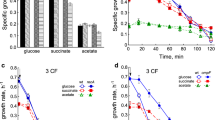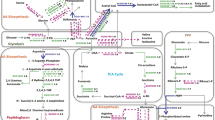Abstract
Uncouplers of oxidative phosphorylation dissipate the proton gradient, causing lower ATP production. Bacteria encounter several non-classical uncouplers in the environment, leading to stress-induced adaptations. Here, we addressed the molecular mechanisms responsible for the effects of uncouplers in Escherichia coli. The expression and functions of genes involved in phenotypic antibiotic resistance were studied using three compounds: two strong uncouplers, i.e., Carbonyl cyanide m-chlorophenyl hydrazone (CCCP) and 2,4-Dinitrophenol (DNP), and one moderate uncoupler, i.e., Sodium salicylate (NaSal). Quantitative expression studies demonstrated induction of transcripts encoding marA, soxS and acrB with NaSal and DNP, but not CCCP. Since MarA and SoxS are degraded by the Lon protease, we investigated the roles of Lon using a lon-deficient strain (Δlon). Compared to the wild-type strain, Δlon shows compromised growth upon exposure to NaSal or 2, 4-DNP. This sensitivity is dependent on marA but not rob and soxS. On the other hand, the Δlon strain shows enhanced growth in the presence of CCCP, which is dependent on acrB. Interestingly, NaSal and 2,4-DNP, but not CCCP, induce resistance to antibiotics, such as ciprofloxacin and tetracycline. This study addresses the effects of uncouplers and the roles of genes involved during bacterial growth and phenotypic antibiotic resistance. Strong uncouplers are often used to treat wastewater, and these results shed light on the possible mechanisms by which bacteria respond to uncouplers. Also, the rampant usage of some uncouplers to treat wastewater may lead to the development of antibiotic resistance.





Similar content being viewed by others
Data Availability
The data underlying this article will be shared with the corresponding author at a reasonable request.
References
Lewis K, Naroditskaya V, Ferrante A, Fokina I (1994) Bacterial resistance to uncouplers. J Bioenerg Biomembr 26(6):639–646. https://doi.org/10.1007/BF00831539
Kashket ER (1985) The proton motive force in bacteria: a critical assessment of methods. Annu Rev Microbiol 39:219–242. https://doi.org/10.1146/annurev.mi.39.100185.001251
Gage DJ, Neidhardt FC (1993) Adaptation of Escherichia coli to the uncoupler of oxidative phosphorylation 2,4-dinitrophenol. J Bacteriol 175(21):7105–7108. https://doi.org/10.1128/jb.175.21.7105-7108.1993
Detchanamurthy S, Gostomski P (2012) Metabolic uncouplers in environmental research: a critical review. Rev Chem Eng 28(4–6):309–317. https://doi.org/10.1515/revce-2012-0004
Date T, Zwizinski C, Ludmerer S, Wickner W (1980) Mechanisms of membrane assembly: effects of energy poisons on the conversion of soluble M13 coliphage procoat to membrane-bound coat protein. Proc Natl Acad Sci USA 77(2):827–831. https://doi.org/10.1073/pnas.77.2.827
Ito M, Ohnishi Y, Itoh S, Nishimura M (1983) Carbonyl cyanide-m-chlorophenyl hydrazone-resistant Escherichia coli mutant that exhibits a temperature-sensitive unc phenotype. J Bacteriol 153(1):310–315. https://doi.org/10.1128/jb.153.1.310-315.1983
Jones MR, Beechey RB (1987) Escherichia coli mutants resistant to uncouplers of oxidative phosphorylation. J Gen Microbiol 133(10):2759–2766. https://doi.org/10.1099/00221287-133-10-2759
Sedgwick E, Hou C, Bragg P (1984) Effect of uncouplers on the bioenergetic properties of a carbonyl cyanide m-chlorophenylhydrazone-resistant mutant Escherichia coli UV6. Biochim et Biophys Acta (BBA) - Bioenergetics 767:479–492. https://doi.org/10.1016/0005-2728(84)90046-X
Sedgwick EG, Bragg PD (1986) Uncoupler-induced relocation of elongation factor Tu to the outer membrane in an uncoupler-resistant mutant of Escherichia coli. Biochim Biophys Acta 856(1):50–58. https://doi.org/10.1016/0005-2736(86)90009-x
Lomovskaya O, Lewis K (1992) Emr, an Escherichia coli locus for multidrug resistance. Proc Natl Acad Sci USA 89(19):8938–8942. https://doi.org/10.1073/pnas.89.19.8938
Griffith JM, Basting PJ, Bischof KM, Wrona EP, Kunka KS, Tancredi AC, Moore JP, Hyman MRL, Slonczewski JL (2019) Experimental evolution of Escherichia coli K-12 in the Presence of Proton Motive Force (PMF) Uncoupler Carbonyl Cyanide m-Chlorophenylhydrazone selects for mutations affecting PMF-Driven drug Efflux Pumps. Appl Environ Microbiol 85(5):e02792–e02718. https://doi.org/10.1128/AEM.02792-18
Holden ER, Webber MA (2020) MarA, RamA, and SoxS as mediators of the stress response: survival at a cost. Front Microbiol 11:828. https://doi.org/10.3389/fmicb.2020.00828
Duval V, Lister IM (2013) MarA, SoxS and Rob of Escherichia coli - Global regulators of multidrug resistance, virulence and stress response. Int J Biotechnol Wellness Industries 2(3):101–124. https://doi.org/10.6000/1927-3037.2013.02.03.2
Chubiz LM, Rao CV (2010) Aromatic acid metabolites of Escherichia coli K-12 can induce the marRAB operon. J Bacteriol 192(18):4786–4789. https://doi.org/10.1128/JB.00371-10
Bhaskarla C, Das M, Verma T, Kumar A, Mahadevan S, Nandi D (2016) Roles of lon protease and its substrate MarA during sodium salicylate-mediated growth reduction and antibiotic resistance in Escherichia coli. Microbiology 162(5):764–776. https://doi.org/10.1099/mic.0.000271
Verma T, Bhaskarla C, Sadhir I, Sreedharan S, Nandi D (2018) Non-steroidal anti-inflammatory drugs, acetaminophen and ibuprofen, induce phenotypic antibiotic resistance in Escherichia coli: roles of marA and acrB. FEMS Microbiol Lett 365(22). https://doi.org/10.1093/femsle/fny251
Greenberg JT, Demple B (1989) A global response induced in Escherichia coli by redox-cycling agents overlaps with that induced by peroxide stress. J Bacteriol 171(7):3933–3939. https://doi.org/10.1128/jb.171.7.3933-3939.1989
Chubiz LM, Glekas GD, Rao CV (2012) Transcriptional cross talk within the mar-sox-Rob regulon in Escherichia coli is limited to the rob and marRAB operons. J Bacteriol 194(18):4867–4875. https://doi.org/10.1128/JB.00680-12
Datsenko KA, Wanner BL (2000) One-step inactivation of chromosomal genes in Escherichia coli K-12 using PCR products. Proc Natl Acad Sci USA 97(12):6640–6645. https://doi.org/10.1073/pnas.120163297
Yang NC, Ho WM, Chen YH, Hu ML (2002) A convenient one-step extraction of cellular ATP using boiling water for the luciferin-luciferase assay of ATP. Anal Biochem 306(2):323–327. https://doi.org/10.1006/abio.2002.5698
Bustin SA, Benes V, Garson JA, Hellemans J, Huggett J, Kubista M, Mueller R, Nolan T, Pfaffl MW, Shipley GL, Vandesompele J, Wittwer CT (2009) The MIQE guidelines: minimum information for publication of quantitative real-time PCR experiments. Clin Chem 55(4):611–622. https://doi.org/10.1373/clinchem.2008.112797
Gambino L, Gracheck SJ, Miller PF (1993) Overexpression of the MarA positive regulator is sufficient to confer multiple antibiotic resistance in Escherichia coli. J Bacteriol 175(10):2888–2894. https://doi.org/10.1128/jb.175.10.2888-2894.1993
Ariza RR, Cohen SP, Bachhawat N, Levy SB, Demple B (1994) Repressor mutations in the marRAB operon that activate oxidative stress genes and multiple antibiotic resistance in Escherichia coli. J Bacteriol 176(1):143–148. https://doi.org/10.1128/jb.176.1.143-148.1994
Price CT, Lee IR, Gustafson JE (2000) The effects of salicylate on bacteria. Int J Biochem Cell Biol 32(10):1029–1043. https://doi.org/10.1016/s1357-2725(00)00042-x
Elliott TS, Shelton A, Greenwood D (1987) The response of Escherichia coli to ciprofloxacin and norfloxacin. J Med Microbiol 23(1):83–88. https://doi.org/10.1099/00222615-23-1-83
Bos J, Zhang Q, Vyawahare S, Rogers E, Rosenberg SM, Austin RH (2015) Emergence of antibiotic resistance from multinucleated bacterial filaments. Proc Natl Acad Sci USA 112(1):178–183. https://doi.org/10.1073/pnas.1420702111
Ishii Y, Amano F (2001) Regulation of SulA cleavage by Lon protease by the C-terminal amino acid of SulA, histidine. Biochem J 358(Pt 2):473–480. https://doi.org/10.1042/0264-6021:3580473
Nazir A, Harinarayanan R (2015) Inactivation of cell division protein FtsZ by SulA makes Lon Indispensable for the viability of a ppGpp0 strain of Escherichia coli. J Bacteriol 198(4):688–700. https://doi.org/10.1128/JB.00693-15
Matange N (2020) Highly Contingent phenotypes of lon protease Deficiency in Escherichia coli upon Antibiotic Challenge. J Bacteriol 202(3):e00561–e00519. https://doi.org/10.1128/JB.00561-19
Campos M, Govers SK, Irnov I, Dobihal GS, Cornet F, Jacobs-Wagner C (2018) Genomewide phenotypic analysis of growth, cell morphogenesis, and cell cycle events in Escherichia coli. Mol Syst Biol 14(6):e7573. https://doi.org/10.15252/msb.20177573
Ansari S, Walsh JC, Bottomley AL, Duggin IG, Burke C, Harry EJ (2021) A newly identified prophage-encoded gene, ymfM, causes SOS-inducible filamentation in Escherichia coli. J Bacteriol 203(11):e00646–e00620. https://doi.org/10.1128/JB.00646-20
Anes J, McCusker MP, Fanning S, Martins M (2015) The ins and outs of RND efflux pumps in Escherichia coli. Front Microbiol 6:587. https://doi.org/10.3389/fmicb.2015.00587
Heuveling J, Possling A, Hengge R (2008) A role for lon protease in the control of the acid resistance genes of Escherichia coli. Mol Microbiol 69(2):534–547. https://doi.org/10.1111/j.1365-2958.2008.06306.x
Cohen SP, Levy SB, Foulds J, Rosner JL (1993) Salicylate induction of antibiotic resistance in Escherichia coli: activation of the mar operon and a mar-independent pathway. J Bacteriol 175(24):7856–7862. https://doi.org/10.1128/jb.175.24.7856-7862.1993
Moore JP, Li H, Engmann ML, Bischof K, Kunka KS, Harris ME, Tancredi AC, Ditmars FS, Basting PJ, George NS, Bhagwat AA, Slonczewskia JL (2019) Inverted regulation of Multidrug Efflux pumps, Acid Resistance, and Porins in Benzoate-Evolved Escherichia coli K-12. Appl Environ Microbiol 85:e00966–e00919. https://doi.org/10.1128/AEM.00966-19
Osei Sekyere J, Amoako DG (2017) Carbonyl Cyanide m-Chlorophenylhydrazine (CCCP) reverses resistance to Colistin, but not to Carbapenems and Tigecycline in Multidrug-Resistant Enterobacteriaceae. Front Microbiol 8:228. https://doi.org/10.3389/fmicb.2017.00228
Baron SA, Rolain JM (2018) Efflux pump inhibitor CCCP to rescue colistin susceptibility in mcr-1 plasmid-mediated colistin-resistant strains and Gram-negative bacteria. J Antimicrob Chemother 73(7):1862–1871. https://doi.org/10.1093/jac/dky134
Watanabe R, Doukyu N (2014) Improvement of organic solvent tolerance by disruption of the lon gene in Escherichia coli. J Biosci Bioeng 118(2):139–144. https://doi.org/10.1016/j.jbiosc.2014.01.011
Nicoloff H, Andersson DI (2013) Lon protease inactivation, or translocation of the lon gene, potentiate bacterial evolution to antibiotic resistance. Mol Microbiol 90(6):1233–1248. https://doi.org/10.1111/mmi.12429
Piddock LJ (2006) Multidrug-resistance efflux pumps - not just for resistance. Nat Rev Microbiol 4(8):629–636. https://doi.org/10.1038/nrmicro1464
Sun J, Deng Z, Yan A (2014) Bacterial multidrug efflux pumps: mechanisms, physiology and pharmacological exploitations. Biochem Biophys Res Commun 453(2):254–267. https://doi.org/10.1016/j.bbrc.2014.05.090
Kurenbach B, Marjoshi D, Amábile-Cuevas CF, Ferguson GC, Godsoe W, Gibson P, Heinemann JA (2015) Sublethal exposure to commercial formulations of the herbicides dicamba, 2,4-dichlorophenoxyacetic acid, and glyphosate cause changes in antibiotic susceptibility in Escherichia coli and Salmonella enterica Serovar Typhimurium. mBio 6(2):e00009–15. https://doi.org/10.1128/mBio.00009-15
Singh S, Verma T, Nandi D, Umapathy S (2022) Herbicides 2,4-Dichlorophenoxy Acetic Acid and Glyphosate induce distinct biochemical changes in E. Coli during phenotypic antibiotic resistance: a Raman Spectroscopic Study. J Phys Chem 126(41):8140–8154. https://doi.org/10.1021/acs.jpcb.2c04151
Acknowledgements
The authors thank all members of the DpN laboratory for their suggestions and support for this study.
Funding
The study was supported by a grant from the Department of Biotechnology BT/PR27585/MED/29/1282/2018. We thank the DBT-IISc partnership grant and infrastructural support from the FIST program of the Department of Science and Technology, India to the Department of Biochemistry, IISc.
Author information
Authors and Affiliations
Contributions
DN conceived the idea based on preliminary studies by CB. Most experiments were performed by TV, VS, AR and HA. SSN and AKD performed some experiments. TV, SSN and DN analyzed the data. TV, CB, SSN and DN prepared the final manuscript.
Corresponding author
Ethics declarations
Ethics Approval
This study did not require ethics approval.
Consent to Participate
No humans were used in this study so informed consent was not required.
Consent to Publish
All authors of this study are in favor of its publication.
Competing Interests
The authors declare no competing financial interests.
Additional information
Publisher’s Note
Springer Nature remains neutral with regard to jurisdictional claims in published maps and institutional affiliations.
Electronic Supplementary Material
Below is the link to the electronic supplementary material.
Rights and permissions
Springer Nature or its licensor (e.g. a society or other partner) holds exclusive rights to this article under a publishing agreement with the author(s) or other rightsholder(s); author self-archiving of the accepted manuscript version of this article is solely governed by the terms of such publishing agreement and applicable law.
About this article
Cite this article
Verma, T., Nandini, S.S., Singh, V. et al. Divergent Roles of Escherichia Coli Encoded Lon Protease in Imparting Resistance to Uncouplers of Oxidative Phosphorylation: Roles of marA, rob, soxS and acrB. Curr Microbiol 81, 98 (2024). https://doi.org/10.1007/s00284-024-03632-w
Received:
Accepted:
Published:
DOI: https://doi.org/10.1007/s00284-024-03632-w




